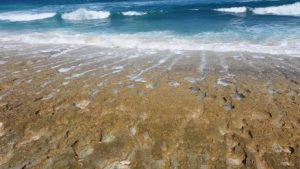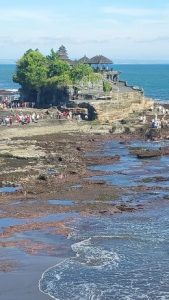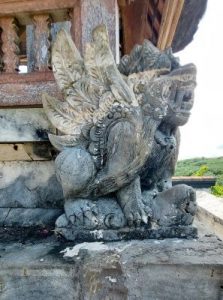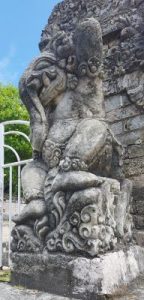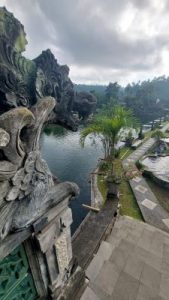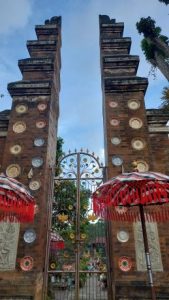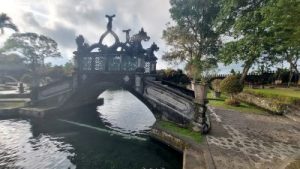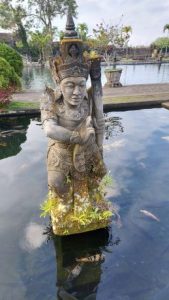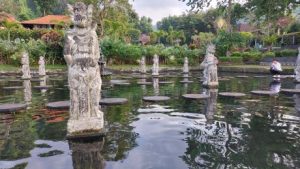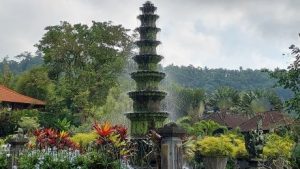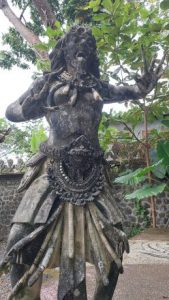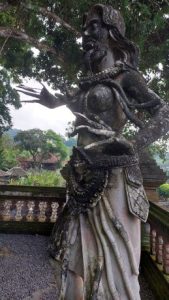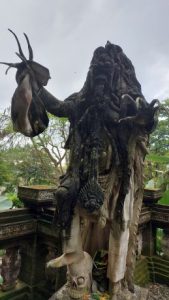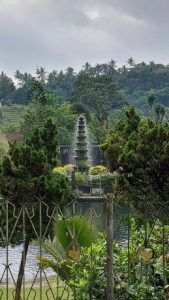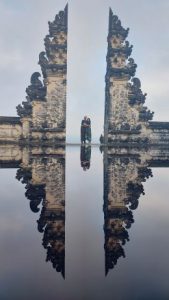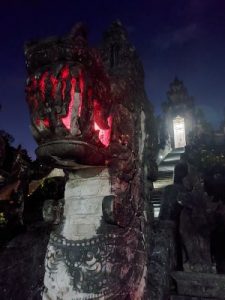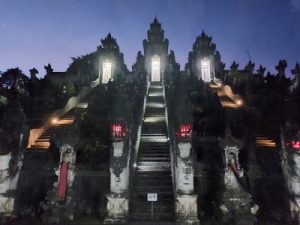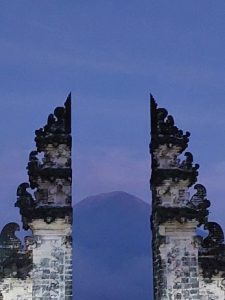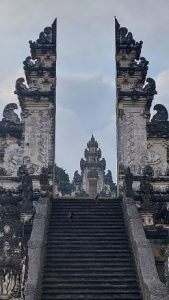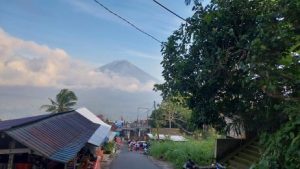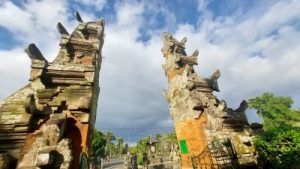
My partner and I have just been in Thailand. But before I put anything on my blog about that, I suppose I’d better post this last instalment about our experiences in Bali…
Taman Ayun Temple
This was our first stop on a tour we did with a spritely, 60-something Balinese guide who spoke English with an Australian accent – the result of years ferrying Australian tourists around the island’s attractions. Also, his raspy tones made him sound like an Australian Keith Richards. Appropriately, he complained about how life had been in Indonesia during the brutal military regime of General Suharto, who among his many sins had banned Western rock music. Our guide recalled the joy of being able to listen to the likes of Led Zeppelin and AC/DC after Suharto’s departure in 1998.
Unlike the Balinese mountain and coastal temples we visited, Taman Ayun Temple was sedate in its topography. Its buildings, compounds, stone-tiled paths, lawns, gardens, trees and green-painted, Victorian-style lampposts were arranged over a flat strip of ground contained within a long, narrow, U-shaped waterway. But I liked it because we arrived early, before other tourists, and had the premises to ourselves. I especially liked wandering the sides of the complex and looking across the water – tall, thin, poplar trees spearing it with their reflections. And at the temple’s far end were paths leading into some woodland with immensely fibrous and creepered banyan trees. That part was the closest I got to exploring Bali’s nature during our holiday.
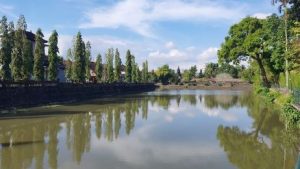
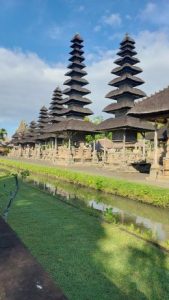
Typically for Balinese temples, there were tapering, tiered pagodas shaped like stacks of ceramic bushings you’d find in an electrical substation. And at the end of the circuit we made around Taman Ayun, we encountered a display-area that was half-gallery, half-museum. In addition to many traditional and modern paintings, it had on show a trio of shaggy Balinese demon costumes. These included one of Rangda, whom Wikipedia describes as “the demon queen of the Leyaks in Bali… Terrifying to behold, the child-eating Rangda leads an army of evil witches against… the forces of good.”
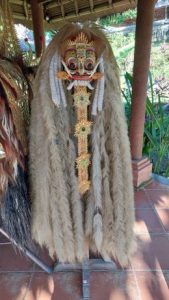
Coffee Plantation
We’d known a coffee plantation was included on our tour itinerary. Unfortunately beforehand, we hadn’t given it much thought – or done any research.
We were shown around the plantation and ended up in a treehouse-café that resembled Tarzan’s jungle home in one of the old movies featuring Johnny Weissmuller. It looked particularly Tarzan-esque because of a catwalk that snaked from it, through the treetops, to a platform where you could take photos of the adjacent mountains, round, blue and caressed by tufts of passing cloud. In the café we were presented with 17 little tasting glasses containing 17 differently flavoured and coloured coffees, teas and other plantation-produced drinks.
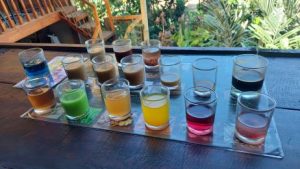
What soured our experience there was the sudden appearance of a luwak, a type of civet used extensively in the production of ‘luwak coffee’. The process, to quote a somewhat ungrammatical information sign at the plantation, goes like this: “Luwak eats coffee beans that are still intact… Through the luwak digestive system, undergoes natural chemical treatment, fermenting in the stomach and come out with excrement… The taste very unique! Fermentation in the luwak stomach make low caffeine. It has rich flavour like almond chocolate taste and very smooth.” In other words, luwak coffee is made from beans eaten, digested and shat out by luwaks, which supposedly have less caffeine but a richer, smoother, more chocolatey taste.
A plantation staff-member brought a luwak around the café’s tables so the visitors could look at it. The poor beast seemed befuddled. Worse, when it was brought to us, the luwak panicked, sprang out of the staff-member’s hands onto my left arm, clambered across my shoulders and descended my right arm before being captured again. Upset by this, my partner consulted her smartphone. She discovered that luwaks should be fed on a varied diet of fruit, seeds and insects, not the monotonous, nutritiously-deficient diet of coffee beans they get at the plantations. They’re also confined to small cages and, as shy, nocturnal animals, being displayed to tourists during the daytime traumatises them.
I know – in all cultures, animals used in the production of food are usually treated cruelly. I’m well aware of that, being from a farming background. But the poor old luwaks could at least be spared the indignity of being dragged from their cages, during daytime, for tourists to gawk at. If we’re in Bali again, we’ll make sure coffee plantations aren’t on the itineraries of any tours we do.
Ulun Danu Beratan Temple
This temple complex was beautifully sited on the shore of Lake Beratan in central Bali. The view you got from it across the water was, basically, a rhapsody in blue: the shimmering, rippling, glassy blue of the lake, the solider green-blue of the Bedugul Mountains rising above the lake’s far rim, the crystal-clear blue of the sky. Also, horticulturalists would love the place even if they didn’t walk as far as the temple-buildings. The approach was gorgeously landscaped with lawns, flowerbeds, flowery borders and neatly groomed trees.
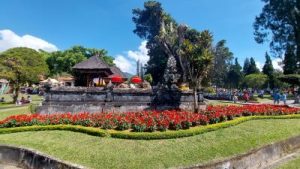
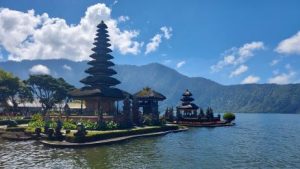
After our experiences a few days earlier at the tourist-infested Lempuyang Temple, it was a relief to be in a Balinese temple that was busy mainly with local people. Crowds of them, both adults and children, had assembled wearing white sarongs and red senteng (shawls bound around the waist) and white or red udeng (traditional Balinese male headdress). Not all the locals had gathered for religious purposes – for, at the lakeshore, a squad of boys were using fishing rods, their lines out in the water among the water-lilies and between the moored wooden boats. However, there were still a few foreigners around. One hideous spectacle that stuck in my mind took place at a stage where folk were invited to don historical Balinese costumes and pose for photographs – a Western lady, no doubt an influencer, had tricked herself out as a Balinese princess and was posing for picture after picture with a nauseating, full-of-herself smile on her visage.
A little disconcertingly, along the shore from the temple buildings, the complex became more family-friendly, with the statues of traditional Balinese deities and mythological creatures giving way to Disney-esque ones of animals: fish, peacocks, parrots. There were also bird-headed paddleboats and even a little compound where youngsters could hang out with and cuddle large fluffy rabbits. Oh well. I suppose parents visiting the temple appreciated it having attractions to keep the kids occupied too.
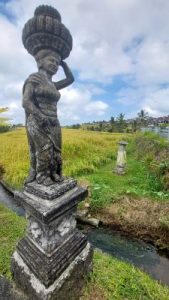
Jatiluwih Rice Terraces
We stopped for lunch at an eatery that was in the middle of this UN World Heritage Site. It’s prized for the traditional rice fields that occupy the multiple terraces scaling its hillsides. When we stopped at a booth to buy our entry tickets for the area, I noticed a sign on the booth listing possible activities on the terraces and the prices that doers of those activities needed to pay. The list of activities ran up to the shooting of movies in the area, by foreign directors, which cost vast amounts of Indonesian rupiah. (The rupiah was currently worth 0.000088 Singaporean dollars, so a lot of zeroes were involved.) Shooting a movie there with a local director was slightly less expensive. As far as I know, the famous shots of Julia Roberts pedalling her bicycle through the rice-fields in Eat, Pray, Love (2010) – or, as I prefer to think of it, Watch, Gag, Puke – were not filmed here.
After we’d eaten, we ventured along a footpath leading in amid the expanses of rice. The rice-fields occupied a slightly-undulating plain of green and yellow, occasionally carved up by lines of trees, which stretched off towards distant, broad mountains. The path was bordered by a channel, full of water, and the edge of the adjacent rice-field collapsed over it, the plants dipping their golden heads in the water as if drinking it.
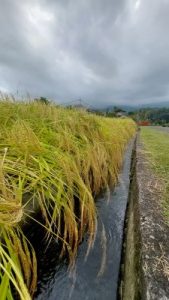
This tour took place on Tumpek Landep Day in Bali, which according to balispirit.com is “a ceremonial day at which offerings are made for objects that are made of metal,” which nowadays include “cars and motorbikes… Most Balinese people truly believe that these ceremonies and blessings will bring them luck and keep them safe in traffic.” Thus, as we drove around, we saw multiple vehicles – stationary and in motion – with charms and rosettes fixed on their bodywork, dangling long, dried strands of coconut-palm leaves.
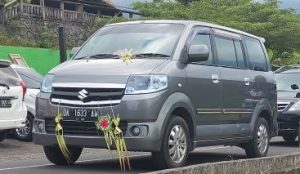
However, these vehicular decorations didn’t sway the police in the city of Ubud, where we were staying. When Balinese / Australian Keith Richards returned us there at the tour’s end, we noticed some 4x4s that were naughtily parked in ‘no parking’ areas along the sides of the main street. To chastise them, the local cops were letting all the air out of their tyres.
Nyang Nyang Beach
We visited this beach three days later, after we’d relocated from Ubud to Uluwata. Its main attraction was the claim it was very cut-off and secluded. A taxi dropped us above the beach. From there we had to descend a long, very steep road that dropped down through a deep cleft cut out of the shoreline’s rock. The sun blazed from the strip of sky visible above. The road looked like it’d be an ordeal to walk up again, but our plan was to follow the beach to its far end, from which, supposedly, a flight of steps climbed back to civilisation. At the bottom of the road we found a parking lot and a ramshackle bar. From there, we stepped down onto the beach itself.
It was busier than we’d expected, both with bronzed teenaged and 20-something bodies lying on the sand sunbathing – or in a few instances, sitting straight-backed, meditating – and with a pod of surfers out on the water, each awaiting his or her turn to ride in on each big wave that passed by. A little way down the beach, we found another ramshackle bar – just a shed with a two solid walls and two open sides, a couple of fridges, an icebox, some clunky old wooden tables and chairs, and battered metal signs advertising rum, mojitos and something called ‘Friendship Coffee Vodka’. We stopped there for a rest. Nearby, a Balinese guy was operating a film camera, pointed in the direction of the surfers. They ‘d hired him to film their surfing antics, clips of which would later be uploaded to their social media accounts.
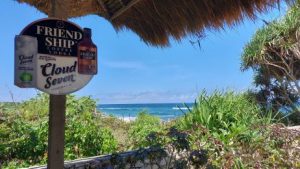
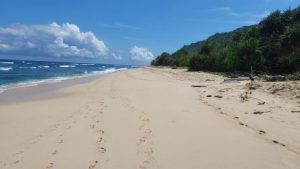
Then we walked further. The other holidaymakers disappeared behind us and we definitely felt the vibe of solitude and isolation that’d drawn us here. Disappointingly, though, Nyang Nyang Beach still had some gunk washed up on its sands: plastic bottles, bottle-tops, cartons, cups and cutlery, and flip-flops and shoe-soles.
At the beach’s far end we found a little old man with an icebox who was selling water, Coca Cola and beer. He showed us the flight of steps, which he proudly told us he went up and down several times a day. Actually, the ‘steps’ were a chaotic track of rocks, earth and rubble, an assault course rather than a staircase, which wound its way up through the vegetation covering the cliff-face. Hurriedly changing our plans, we thanked the old man and made our back along the beach to the bottom of the super-steep road. Luckily, another old guy there with a motorbike offered a ‘taxi’ service – for a fee of 25,000 rupiah, he’d shuttle you up to the top of the road on the back of his bike. My partner rode up with him first.
While waiting for the motorbike to return, I had a quick beer in the bar beside the parking lot. A slogan had been graffiti-ed on a timber column there: ‘F**K EVERYTHING AND BECOME A PIRATE’. Pirates, I thought sourly. That’s what all you wee influencer / Instagramming surf-boys out there are. Modern-day pirates.
Aye, right.


